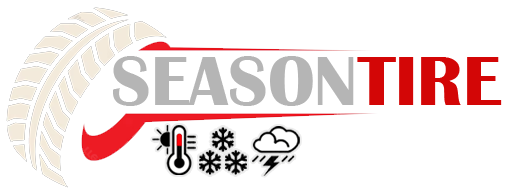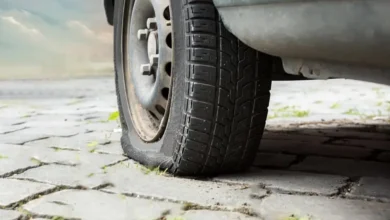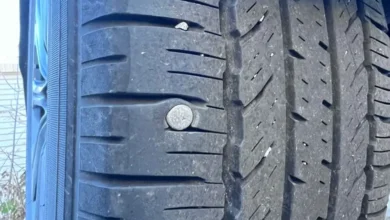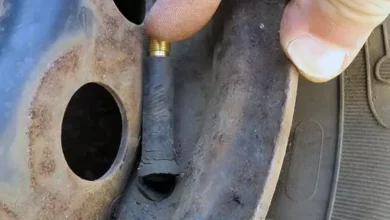
Introduction:
Maintaining the correct tire pressure is crucial for ensuring both safety and optimal performance in your vehicle. Whether underinflated or overinflated Tires, improper tire pressure can negatively impact your car. Properly inflated tires directly influence your car’s handling, fuel efficiency, and overall longevity. When tires are inflated to the recommended pressure, they promote even wear, enhance stability, and significantly reduce the risk of accidents and mechanical issues on the road.
However, driving on overinflated tires even by just 5 psi can lead to a range of dangerous problems. Excess pressure causes tires to become rigid, diminishing their contact area with the road. This not only heightens the risk of tire blowouts but also makes your vehicle more vulnerable when navigating potholes or debris. Moreover, overinflation can result in uneven tread wear, shortening the lifespan of your tires and impairing your vehicle’s braking ability, especially in wet or slippery conditions.
To avoid the pitfalls of overinflation, it’s essential to check your tire pressure regularly—ideally at least twice a month. Properly inflated tires contribute to a smoother, safer ride while improving fuel economy and extending tire life. Additionally, maintaining the correct pressure helps prevent unnecessary wear and tear on other vehicle components, such as the suspension, which can suffer from the impacts of driving on overinflated tires. Prioritizing tire pressure maintenance not only enhances your driving experience but also keeps you and your passengers safe on the road.
What Is Proper Tire Pressure?
Defining Tire Pressure and How It Is Measured in PSI
- Tire pressure refers to the amount of air inside your tires, and it’s typically measured in pounds per square inch (PSI). Proper tire inflation ensures that your tires can support the weight of the vehicle, provide proper traction, and allow for safe handling on the road.
- PSI is the most common unit used for tire pressure in the United States. It indicates how much force the air inside the tire is exerting on the walls of the tire.
Recommended Tire Pressure for Most Vehicles (32-35 PSI)
- For the majority of passenger vehicles, the recommended tire pressure falls within the range of 32 to 35 PSI. This optimal range allows for balanced performance, safety, and fuel efficiency.
- It’s essential to follow the manufacturer’s guidelines for your specific vehicle, as they take into account the weight, size, and handling characteristics of your car when recommending the correct tire pressure. You can usually find this information on a sticker located on the driver’s side door frame or in your vehicle’s manual.
The Effect of Temperature Changes on Tire Pressure
- Tire pressure fluctuates with temperature changes, generally losing about 1 to 2 PSI for every 10-degree Fahrenheit drop in temperature. This is why it’s crucial to check tire pressure more frequently during colder months or after sudden changes in temperature.
- Conversely, in hot conditions, the air inside the tire expands, which could cause the pressure to rise above the recommended level, leading to overinflation. Therefore, it’s best to check tire pressure when the tires are cold, such as in the morning or after the car has been parked for a few hours.
Benefits of Maintaining Correct Tire Inflation
- Longer Tire Life: Properly inflated tires wear evenly, extending their lifespan by reducing the risk of premature tread wear. This helps you get the most out of your tires and saves you money in the long run.
- Better Fuel Economy: Properly inflated tires reduce rolling resistance, allowing the car to move more efficiently, which translates to improved fuel efficiency. Underinflated or overinflated tires can decrease fuel economy, causing you to spend more on gas.
- Improved Safety and Performance: With the right tire pressure, your vehicle handles better, ensuring optimal traction, braking, and overall stability, especially in adverse conditions like rain or snow.
Dangers of Overinflating Tires by 5 Psi:
Increased Risk of Tire Blowouts
- Weakened Tire Integrity: Overinflating a tire by 5 PSI significantly increases the internal pressure on the tire’s structure, making it more rigid. This rigidity compromises the tire’s ability to absorb shocks from the road, making it vulnerable to damage. The increased pressure causes strain on the tire walls, weakening the structural integrity of the tire over time.
- Risks from Potholes and Debris: When a tire is overinflated, hitting potholes, sharp debris, or uneven road surfaces can cause severe damage. Overinflated tires are less flexible, and the reduced ability to absorb impacts can lead to cuts, cracks, or tears, which further increase the chances of a blowout.
- Loss of Control: A tire burst at high speeds is one of the most dangerous outcomes of over-inflation. Blowouts often result in an immediate loss of control, particularly when driving on highways, where quick maneuvers are critical to avoiding accidents. The sudden loss of tire pressure can cause the vehicle to swerve uncontrollably, putting both the driver and others on the road at significant risk.
Weakened Grip and Braking Efficiency
- Reduced Contact Patch: Overinflating tires reduces the size of the tire’s contact patch—the portion of the tire that touches the road. With less rubber making contact with the road, your tires lose significant grip, especially when accelerating, turning, or braking. This reduction in traction increases the likelihood of accidents, particularly in challenging driving conditions like wet or icy roads.
- Hydroplaning Risk: In wet conditions, the reduced contact patch makes the tires more prone to hydroplaning, a phenomenon where a layer of water builds up between the tires and the road. Hydroplaning can cause the vehicle to lose traction entirely, rendering steering, braking, and accelerating ineffective, leading to potential accidents.
- Impact on ABS and Driving Assistance Features: Over-inflation can also reduce the effectiveness of critical safety systems like anti-lock braking systems (ABS) and traction control. These systems rely on proper tire grip to function effectively, and when tires are overinflated, the car’s ability to brake or adjust its speed in emergency situations may be compromised.
Uneven Tread Wear
- Unequal Pressure on the Tread: Overinflated tires tend to wear unevenly, with most of the pressure concentrated in the center of the tire. The tire’s center portion makes most of the contact with the road, while the outer edges see little to no contact. As a result, the middle of the tire wears down more quickly than the sides.
- Faster Wear and Expensive Replacements: This uneven wear reduces the lifespan of your tires, forcing you to replace them more frequently than if they were properly inflated. Tires are an investment, and premature wear due to overinflation can lead to unnecessary expenses. Additionally, overinflated tires that are worn in the center may be more susceptible to punctures and other forms of damage.
Damage to Suspension
- Excessive Shock to Suspension Components: Overinflated tires don’t flex as much when hitting bumps or uneven surfaces, which leads to the vehicle’s suspension bearing the brunt of the impact. The suspension system, designed to absorb shock and ensure a smooth ride, gets strained due to the rigid tires constantly bouncing on the road.
- Long-Term Suspension Damage: Over time, the increased strain on suspension components like shocks, struts, and ball joints can cause them to wear out prematurely. This may lead to costly repairs and decreased vehicle performance, as the suspension is a vital component for maintaining stability, handling, and comfort.
Rough and Uncomfortable Ride
- Jarring Ride Experience: One of the most noticeable effects of overinflated tires is the rough, jarring ride they create. Overinflated tires become stiff, which limits their ability to absorb bumps and irregularities on the road. This results in a more uncomfortable ride for passengers, as every pothole, crack, and bump is felt more intensely.
- Reduced Handling and Control: In addition to comfort issues, overinflated tires compromise vehicle handling. The stiffness of the tires reduces their ability to grip the road during sharp turns or sudden maneuvers, leading to poor handling. This makes it more challenging to maintain control of the vehicle, especially in emergency situations, posing a serious safety hazard.
How to Correct Overinflated Tires:
Overinflating tires can lead to several issues, but the good news is that correcting the tire pressure is straightforward. Below is a step-by-step guide on how to check your tire pressure, release excess air, and ensure your tires are properly inflated.
Step-by-Step Guide on Using a Tire Gauge to Check Tire Pressure
- Gather Your Tools: You’ll need a tire pressure gauge. There are two common types—manual (stick or dial) gauges and digital gauges. Both work well, but digital gauges tend to provide more accurate and easier-to-read results.
- Find the Manufacturer’s Recommended Tire Pressure: Look for a sticker inside the driver’s side door frame or check your vehicle’s manual. This will tell you the correct tire pressure in pounds per square inch (PSI) for both front and rear tires.
- Ensure Tires Are Cold: Tire pressure should be checked when the tires are cold—either first thing in the morning or after the car has been parked for several hours. Driving heats up the tires, causing the air inside to expand, which can lead to a false high reading.
- Remove the Valve Cap: Unscrew the cap on the tire’s air valve (the small, metal or plastic cap that covers the valve stem). Keep it in a safe place so it doesn’t get lost.
- Press the Tire Gauge onto the Valve Stem: Press the gauge onto the valve stem firmly, making sure there’s no hissing sound of escaping air. A good seal is essential for an accurate reading.
- Read the Pressure: If you’re using a manual gauge, the stick or dial will move to show the PSI. For digital gauges, the pressure reading will appear on the screen. Compare this reading to the recommended PSI for your vehicle.
Detailed Instructions on How to Release Excess Air from the Tire
- Locate the Valve Stem: After taking the reading, if you find that your tire is overinflated (5 PSI or more above the recommended level), you’ll need to release some air.
- Use the Small Pin Inside the Valve: Inside the valve stem, you’ll see a small metal pin. To release air, press down on this pin using a tire gauge (most have a built-in air release feature) or the edge of a small tool, like a screwdriver. Make sure to release the air in short bursts rather than continuously.
- Check the Pressure Again: After releasing some air, recheck the tire pressure using your gauge. You may need to repeat this process a few times until the PSI is within the recommended range.
- Screw the Valve Cap Back On: Once you’ve corrected the tire pressure, replace the valve cap. This helps keep dirt and moisture out of the valve, ensuring a proper seal.
Tips on How to Ensure Correct Tire Pressure Using a Digital Gauge
- Use a High-Quality Digital Gauge: Digital gauges are often more accurate than manual ones and easier to use. Invest in a high-quality digital tire gauge for precise readings.
- Recheck Regularly: Tire pressure can fluctuate due to temperature changes and driving conditions. Check your tire pressure at least once a month, especially before long trips or during seasonal temperature shifts.
- Monitor Tire Pressure After Releases: After letting air out, always double-check the pressure with your gauge to avoid underinflation. It’s better to release air in small amounts and recheck than to let out too much and have to reinflate.
- Consistency is Key: When checking and adjusting your tire pressure, be consistent. Always check the tires when cold and aim for the recommended PSI every time.
Prevention Tips for Avoiding Overinflation:
Maintaining the correct tire pressure is essential for your vehicle’s safety and performance. Here are some practical prevention tips to help avoid overinflating your tires:
- Recommended Frequency for Checking Tire Pressure
- Check Tire Pressure at Least Twice a Month: Regularly monitoring your tire pressure ensures that your tires are neither overinflated nor underinflated. Tires lose or gain pressure naturally over time due to temperature changes and daily driving, so aim to check your tire pressure at least twice a month.
- Before Long Trips: Always check tire pressure before embarking on a long road trip. Driving on properly inflated tires will help with fuel efficiency and prevent unnecessary wear on your tires.
- Best Practices for Maintaining Proper Tire Pressure
- Check Tire Pressure During Cold Conditions: Tire pressure should be measured when the tires are cold either first thing in the morning or after the car has been parked for several hours. This gives the most accurate reading, as driving heats up the tires and increases air pressure.
- Use a Reliable Tire Gauge: Invest in a good-quality tire pressure gauge, preferably a digital one for better accuracy. Even if your vehicle has a tire pressure monitoring system (TPMS), it’s a good idea to manually check the tire pressure every now and then to ensure accuracy.
- Account for Temperature Changes: As the temperature drops, tire pressure decreases. For every 10°F drop in temperature, your tires can lose about 1 PSI. Make sure to monitor your tire pressure more frequently during the colder months or when the seasons change.
- Importance of Avoiding Overfilling and Knowing Your Vehicle’s Tire Pressure Guidelines
- Avoid Overfilling by Knowing the Recommended PSI: Always check the vehicle’s recommended tire pressure, which is usually found on a sticker inside the driver’s door frame or in the owner’s manual. Don’t rely on the maximum pressure number on the sidewall of the tire—that’s the maximum allowed by the tire manufacturer, not the optimal PSI for your vehicle.
- Do Not Overinflate for Better Performance: Some drivers mistakenly believe that overinflating their tires will improve fuel economy or handling. However, this can have the opposite effect, leading to a rough ride, poor traction, and increased risk of blowouts.
- Regular Maintenance is Key: In addition to checking tire pressure, ensure that your tires are regularly rotated, balanced, and inspected for wear. This will help you spot any potential issues early on and maintain overall tire health.
By following these simple tips, you can prevent over-inflation and maintain optimal tire pressure for safe driving.
Common FAQs About Overinflated Tires:
- Is 5 Psi Overinflated Dangerous?
Yes, being 5 psi over the recommended tire pressure can be dangerous. Overinflated tires reduce the tire’s contact patch with the road, which can weaken grip and braking efficiency. This increases the risk of a blowout, especially if you hit potholes or road debris. Even though it might not seem like much, 5 psi can significantly impact safety and handling.
- What Is the Maximum Safe Psi for Tires?
The maximum safe tire pressure for most vehicles is generally around 35-40 psi, but it’s important to check the manufacturer’s recommendations for your specific car. Exceeding this range can put unnecessary stress on the tire, increasing the risk of blowouts, uneven tread wear, and poor handling. Always follow the guidelines provided on your vehicle’s tire placard or manual.
- Can Overinflated Tires Cause a Blowout?
Yes, overinflated tires are more prone to blowouts. When a tire is inflated beyond its recommended pressure, it becomes stiff, and its structural integrity weakens, especially when driving over potholes or sharp debris. The excess pressure causes the tire to stretch beyond its limits, making a blowout more likely.
- How Can I Tell if My Tires Are Overinflated?
There are a few symptoms to watch for:
- The ride may feel bumpier than usual, as overinflated tires don’t absorb road imperfections well.
- Uneven tread wear, particularly in the center of the tire, indicates overinflation.
- You may notice reduced grip and longer braking distances when driving.
- How Does Temperature Affect Tire Pressure?
Tire pressure increases by about 1 psi for every 10°F rise in temperature. In hot weather, tires can become overinflated as the air inside expands. Conversely, in cold weather, tires may lose pressure. That’s why it’s important to check tire pressure regularly, especially during seasonal changes, to avoid overinflation or underinflation.
- Can Overinflated Tires Affect Fuel Efficiency?
While overinflated tires may slightly reduce rolling resistance and improve fuel efficiency, the safety risks far outweigh any minor fuel savings. Overinflation leads to uneven tire wear, increased blowout risks, and poor handling, making it an unsafe way to save on gas.
- Is It Safe to Deflate Tires After Overinflating?
Yes, it’s safe and necessary to deflate overinflated tires. Use a tire pressure gauge to measure the psi, and release air slowly using the valve stem until the pressure matches the manufacturer’s recommendation. Always ensure you’re adjusting the pressure when the tires are cold, as heat can affect the reading.
- What Tools Do I Need to Check Tire Pressure Accurately?
To check tire pressure accurately, you’ll need a reliable tire pressure gauge, preferably a digital one, as they are more precise than traditional stick gauges. Additionally, an air compressor or a hand pump is helpful to adjust the pressure if necessary. Many gas stations also have air pumps with built-in gauges.
- Can Overinflated Tires Impact Tire Longevity?
Yes, overinflated tires tend to wear out faster, particularly in the center of the tread. Uneven tread wear reduces the overall lifespan of the tire, meaning you’ll need replacements sooner than if the tires were properly inflated.
- Does Overinflation Impact Ride Comfort?
Overinflated tires create a rough and uncomfortable ride. They don’t absorb road bumps and vibrations well, causing the vehicle to feel stiffer and less responsive. This not only affects comfort but also reduces your control over the car, especially on uneven roads.
- How Often Should I Check Tire Pressure to Avoid Overinflation?
It’s recommended to check your tire pressure at least twice a month. Regular checks ensure that the pressure remains within the recommended range and helps avoid both underinflation and overinflation. It’s especially important to check tire pressure before long trips or during significant temperature changes.
- What Should I Do if My Tires Are Overinflated During a Long Trip?
If you notice your tires are overinflated during a long trip, pull over safely and use a tire pressure gauge to check the psi. If the pressure is too high, release air slowly through the valve stem until the tires are at the correct level. Be sure to check again after driving, as pressure can fluctuate with heat.
- Are Overinflated Tires More Likely to Get Damaged by Road Debris?
Yes, overinflated tires are more susceptible to damage from road debris like sharp objects or potholes. The extra pressure makes the tire less flexible and more prone to punctures or cuts when hitting obstacles. Properly inflated tires are better equipped to absorb impacts and resist damage.
- What Happens If I Drive on Overinflated Tires for Too Long?
Driving on overinflated tires for an extended period can cause several issues, including uneven tread wear, reduced traction, and compromised handling. Additionally, the stiff ride can transfer excessive shock to your vehicle’s suspension system, leading to costly repairs. Long-term overinflation can also increase the chances of a blowout.
Conclusion:
Maintaining the proper tire pressure is essential for both your safety and your vehicle’s performance. Overinflated tires may seem harmless, but they can lead to serious issues like blowouts, uneven tread wear, poor handling, and damage to your suspension system. By ensuring your tires are correctly inflated, you’ll enjoy a smoother ride, better fuel efficiency, and longer tire life.
Regular tire pressure checks—at least twice a month—are an easy way to avoid the risks of overinflation. Remember to check your tires during temperature changes and before long trips to ensure they are within the manufacturer’s recommended psi range.
If you’re unsure about how to maintain your tire pressure properly or suspect your tires are overinflated, it’s always best to seek professional help. Keeping your tires in optimal condition not only enhances performance but also ensures a safer driving experience for you and everyone on the road.




